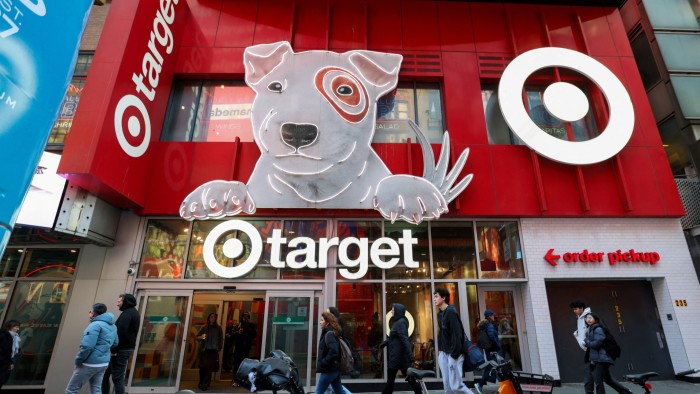Unlock the Editor’s Digest for free
Roula Khalaf, Editor of the FT, selects her favourite stories in this weekly newsletter.
When a company wins a cute nickname from its customers, it’s usually a sign something is going right. That was true for Target, the US retailer of trendy but affordable fashion and home goods widely known by the faux French moniker “Tar-zhay”. But in these unsentimental times, investors are focused on targets of a more prosaic kind.
Target, which reported a 3.8 per cent fall in same-store quarterly sales on Wednesday, is struggling to connect with shoppers as they pull back on discretionary spending. Few are in the mood to splurge on yet another decorative pillow — however stylish it may be — when they are focused on paying their grocery bills. And that’s a problem for Target because nearly 60 per cent of its sales last year came from discretionary spending categories. Groceries made up only 22 per cent of total revenue, compared with 60 per cent at Walmart.

The result has been persistently poor sales at Target’s 1,981 stores. In-store comparable sales were down 5.7 per cent. That is leading to a pile-up in goods. Inventories stood at $13bn as of May 3, a 11 per cent jump from the year-ago period. The company has reduced its estimate of full-year sales and adjusted earnings.
Target shares have fallen 64 per cent from their 2021 peak and hit a five-year low last month. Since chief executive Brian Cornell’s contract is set to expire this year, the Minneapolis-based company increasingly looks like a prime candidate for an activist investor. Such an agitator would find their case strengthened by the relatively strong performance of Walmart and Costco. Shares of both have more than doubled over the past three years.

Some things — like the impact on costs of Donald Trump’s tariffs — are out of Target’s control. But the company is not helping itself. Its retreat from diversity initiatives has angered some of its customers.
Its solution to its sales woes is to try and invoke the “Tar-zhay magic”, a phrase management used repeatedly in Wednesday’s call with analysts. But the magic is no longer unique. Walmart and other retailers have caught up, moving in on Target’s middle- and higher-income shoppers with their own private label clothing and home goods brands. Walmart’s US same-store sales, excluding fuel, were up 4.5 per cent during the first quarter. Its US e-commerce sales increased by 22 per cent, compared to Target’s 4.7 per cent rise.
Target’s product mix, which remains heavily skewed towards general merchandising instead of groceries, means sales will remain under pressure. When times are hard, seasonal vegetables sell faster than seasonal-themed throws.


